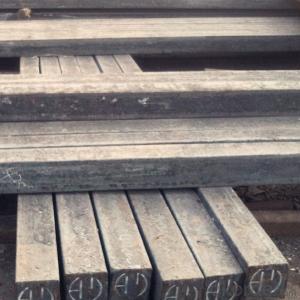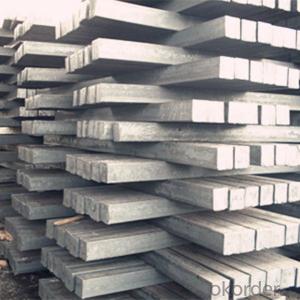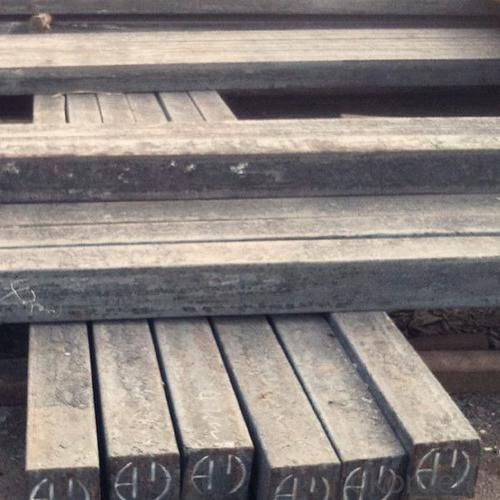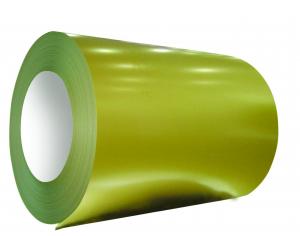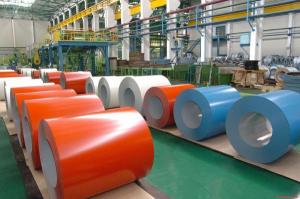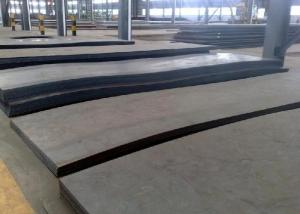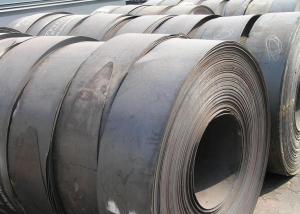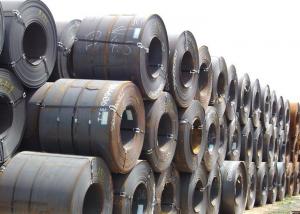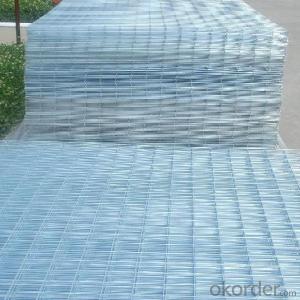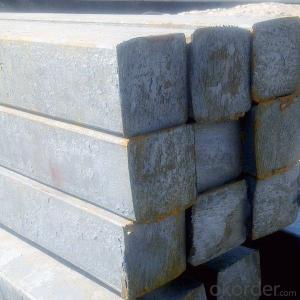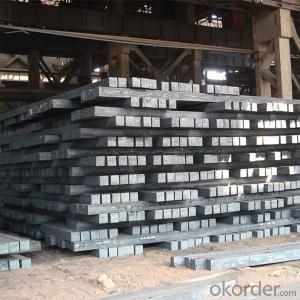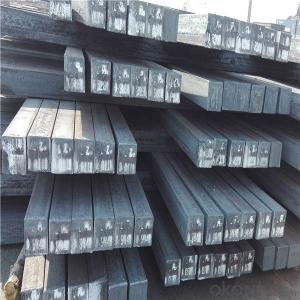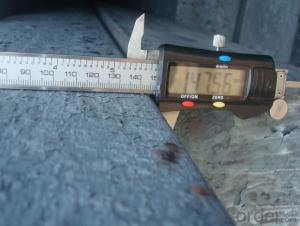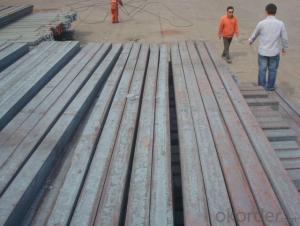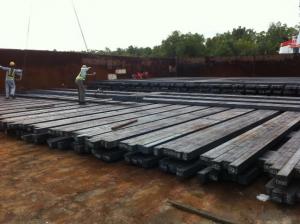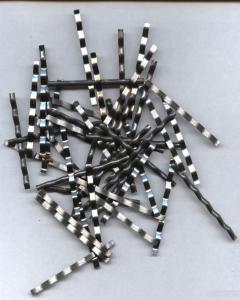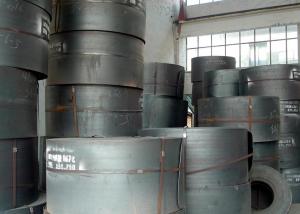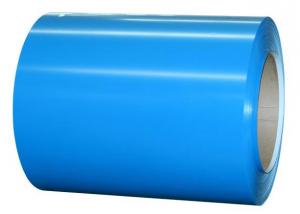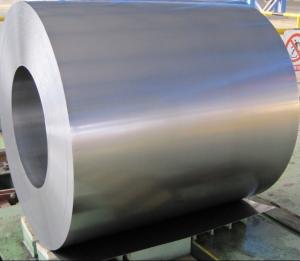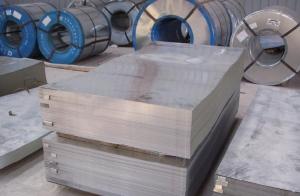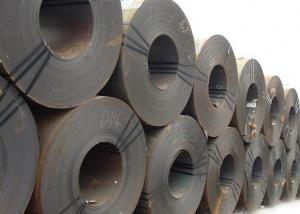100x100mm 130x130mm 150x150mm Prime Square Steel Billet
- Loading Port:
- China main port
- Payment Terms:
- TT OR LC
- Min Order Qty:
- 20 m.t.
- Supply Capability:
- 10000 m.t./month
OKorder Service Pledge
OKorder Financial Service
You Might Also Like
Specification
Prime Square Steel Billet
Size List
| 60x60mm | 80x80mm | 100x100mm |
| 125x125mm | 130x130mm | 150x150mm |
Chemical Comosition
Standard | C(%) | Mn(%) | S(%) | P(%) | Si(%) |
Q195 | ≤0.12 | ≤0.50 | ≤0.040 | ≤0.035 | ≤0.30 |
Q235 | ≤0.20 | ≤1.40 | ≤0.045 | ≤0.045 | ≤0.35 |
Q275 | ≤0.22 | ≤1.50 | ≤0.045 | ≤0.045 | ≤0.35 |
20MnSi | 0.17-0.25 | 1.2-1.6 | ≤ 0.050 | ≤ 0.050 | 0.40-0.80 |
3SP | 0.14-0.22 | 0.40-0.85 | ≤ 0.050 | ≤ 0.040 | 0.05-0.15 |
5SP | 0.28-0.37 | 0.50-1.00 | ≤ 0.050 | ≤ 0.040 | 0.15-0.30 |
| Application |
Angle bar ,Steel Channel,I beam,H beam,Flat bar making.
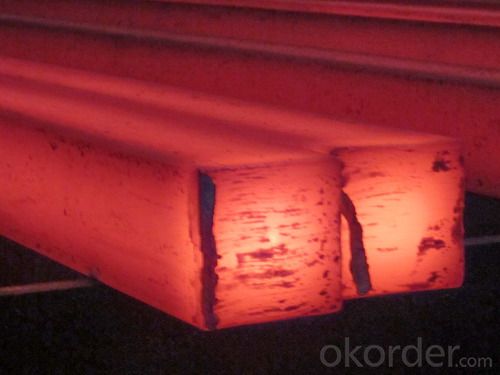
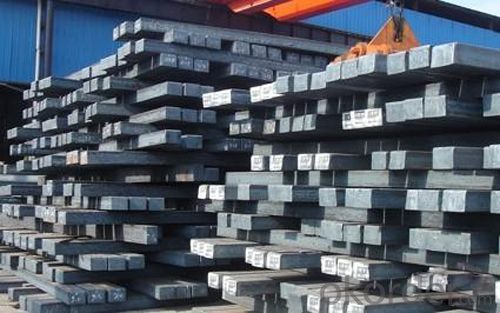
FAQ
Q1: Are you trading or manufacturer?
A1: We are manufacturer with exporting rights;
Q2: How many years have you engaged in this products?
A2: More than 10 years;
Q3: How could you guarantee your quality?
A3: The third inspection can be available,such as: SGS,ISO
Q4: What will you do if buyer ask claim?
A4: We will accept and pay fully to buyer If it's really our responsibility after checking.
Q5: Could you supply samples?
A5: Yes,we can
Q6: What's your payment method?
A6: LC at sight for large quantity,and TT for small orders.
- Q: What are the common manufacturing processes involved in producing steel products?
- The common manufacturing processes involved in producing steel products include melting and refining of iron ore, which is then transformed into molten steel. This molten steel is then cast into various shapes through processes such as casting, rolling, forging, or extrusion. After shaping, the steel may undergo heat treatment, surface treatment, and finishing processes such as machining, grinding, or coating to achieve the desired properties and appearance.
- Q: What are the different types of steel sheets and their uses in the packaging industry?
- There are several types of steel sheets used in the packaging industry, including tinplate, galvanized steel, and stainless steel. Tinplate is a thin steel sheet coated with a layer of tin, making it highly resistant to corrosion. It is commonly used for making food cans and beverage containers due to its ability to preserve the contents' freshness. Galvanized steel sheets are coated with a layer of zinc, which provides excellent rust resistance. They are often utilized for packaging materials that require durability and strength, such as metal drums and pails. Stainless steel sheets, known for their corrosion resistance and hygienic properties, are used in the packaging industry for applications like pharmaceutical packaging, cosmetic containers, and high-end food packaging.
- Q: What are the different types of steel wire and cables available?
- There are several different types of steel wire and cables available, including galvanized steel wire, stainless steel wire, carbon steel wire, and alloy steel wire. Each type has its own unique properties and applications, making them suitable for various industries such as construction, automotive, and telecommunications.
- Q: How are steel products used in the construction of religious buildings and places of worship?
- Steel products are commonly used in the construction of religious buildings and places of worship due to their strength, durability, and versatility. They are utilized in various structural components, such as beams, columns, and trusses, to provide stability and support to the entire structure. Steel is also used for roofing, cladding, and facade systems, offering protection against weather elements while adding aesthetic appeal. Additionally, steel is used in the construction of stairs, railings, and decorative elements, enhancing the overall design and functionality of religious buildings.
- Q: What are the advantages of using steel in bridge construction?
- There are several advantages of using steel in bridge construction. Firstly, steel is known for its high strength-to-weight ratio, making it an ideal material for building bridges that can handle heavy loads while remaining structurally sound. Secondly, steel possesses excellent durability and resistance to corrosion, which ensures a longer lifespan for the bridge and reduces maintenance costs. Additionally, steel bridges can be fabricated off-site and assembled quickly, leading to shorter construction periods and less disruption to traffic. Lastly, steel is a sustainable material as it can be recycled, making it an environmentally friendly choice for bridge construction.
- Q: What are the different types of steel products used in the manufacturing of sports equipment?
- The different types of steel products commonly used in the manufacturing of sports equipment include stainless steel, carbon steel, alloy steel, and tool steel. Each type of steel possesses unique properties and characteristics that make them suitable for specific applications in sports equipment manufacturing. Stainless steel is corrosion-resistant and commonly used in the production of golf club heads, baseball bats, and tennis rackets. Carbon steel, known for its strength and durability, is used in the fabrication of bicycle frames, barbells, and weight plates. Alloy steel, which combines different metals to enhance specific properties, is often used in the construction of high-performance sports equipment such as bicycle gears and golf club shafts. Tool steel, valued for its hardness and ability to retain sharp edges, is utilized in the manufacturing of ice skates, hockey sticks, and knife blades.
- Q: How is steel plate cut using CNC machines for fabrication?
- Steel plate is cut using CNC machines for fabrication through a process called plasma cutting or laser cutting. In plasma cutting, an electrically conductive gas is passed through a nozzle at high speeds, creating a plasma arc that melts and blows away the metal. Laser cutting, on the other hand, uses a high-powered laser beam to melt and vaporize the steel plate, resulting in precise and clean cuts. Both methods are controlled by CNC machines, which follow programmed instructions to accurately cut the steel plate into desired shapes and sizes.
- Q: What are the different types of steel bars and their applications?
- There are several types of steel bars, each with their own distinct characteristics and applications. Some common types include mild steel bars, deformed steel bars, stainless steel bars, and alloy steel bars. Mild steel bars are widely used in construction due to their affordability and versatility. They are commonly used for general reinforcement purposes in buildings, bridges, and other structures. Deformed steel bars, on the other hand, have ridges or deformations on their surface which enhance their bonding with concrete. These bars are extensively used in reinforced concrete structures such as columns, beams, and slabs. Stainless steel bars are highly resistant to corrosion and are used in environments where corrosion is a concern, such as in marine applications, food processing industries, and chemical plants. Alloy steel bars are made by adding different alloying elements to enhance specific properties like strength, hardness, and resistance to wear and tear. They are commonly used in the manufacturing of automobile parts, machinery, and tools. In summary, the different types of steel bars cater to various applications based on their specific properties, making them suitable for a wide range of industries and construction projects.
- Q: What are the different types of steel products used in the manufacturing of baby products?
- There are various types of steel products used in the manufacturing of baby products. Some common examples include stainless steel for bottles, utensils, and pacifiers, as well as steel frames for strollers and cribs. These steel products are chosen for their durability, hygiene, and safety features, ensuring the well-being of infants.
- Q: How are steel products used in the manufacturing of machinery?
- Steel products are used extensively in the manufacturing of machinery due to their strength, durability, and versatility. They are commonly used to construct machine frames, gears, shafts, and other components that require high strength and resistance to wear and tear. Additionally, steel is often utilized in the manufacturing of molds and dies, which are essential for shaping and forming various machine parts.
Send your message to us
100x100mm 130x130mm 150x150mm Prime Square Steel Billet
- Loading Port:
- China main port
- Payment Terms:
- TT OR LC
- Min Order Qty:
- 20 m.t.
- Supply Capability:
- 10000 m.t./month
OKorder Service Pledge
OKorder Financial Service
Similar products
Hot products
Hot Searches
Related keywords
